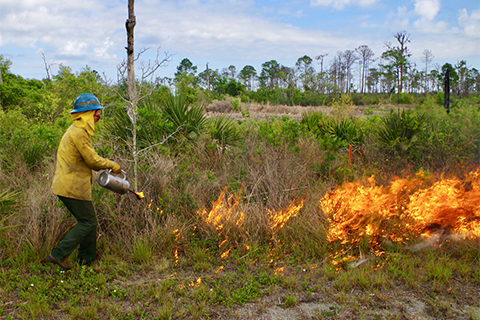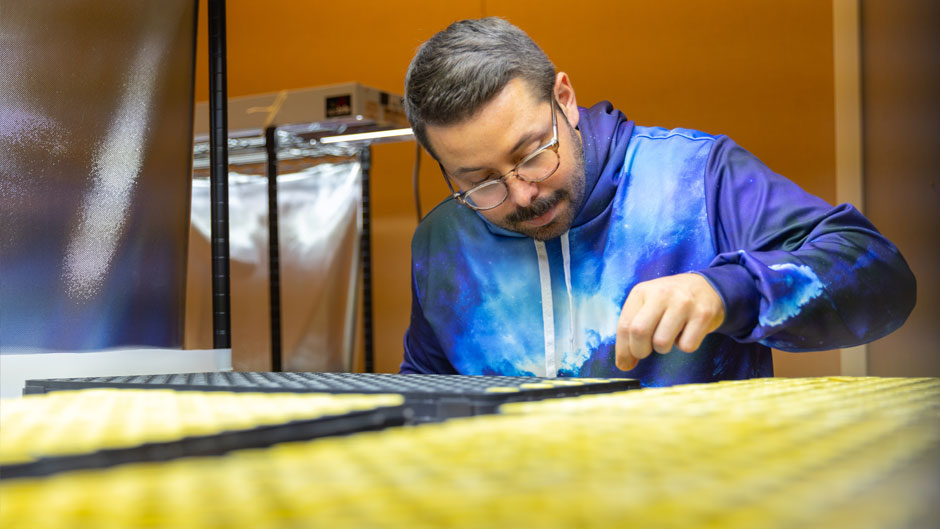For the past two weeks, post-doctoral researcher Daniel Revillini has been planting thousands of seeds—some smaller than a speck of dust, others the size of a grain of rice—into hundreds of tiny pots in a makeshift grow house in the basement of the Cox Science Building.
The task is tedious and painstaking, but has the tantalizing goal of unlocking the secrets of the hidden microbes that could help some of the rarest plants on Earth, those found only on Central Florida’s imperiled Lake Wales Ridge, continue to thrive in a changing climate.
“It’s a lot of logistics and a lot of finicky work, but once you get it done, all you do is water them, and hopefully watch them grow,” Revillini said, as he spilled seeds from tiny envelopes and, with a pair of tweezers, carefully dropped them on top of an array of soils in hundreds of yellow “conetainers.”
Each of the 1-inch by 1-inch cone-shaped pots contains anywhere from three to 30 seeds collected from a dozen of the small, ground-level herbaceous plants that sprout in the sandy, bald spots near Florida rosemary, the dominant species in the ever-shrinking Florida scrub habitat. A fragrant shrub unrelated to the popular culinary herb, rosemary scrub has its own natural “Keep Out” sign. Known as an allelopathic plant, it produces chemicals that inhibit the growth of other plants.
Yet about 80 different species of the herbaceous plants, many of them endangered or found nowhere else, still manage to grow in the gaps amid the rosemary, prompting University of Miami assistant professors of biology Michelle Afkhami and Christopher Searcy to investigate whether fungi, bacteria, and other microorganisms in the soil of those rosemary balds are the “hidden drivers” that explain why.
In research to be published in a forthcoming peer-reviewed journal, Afkhami, Searcy, and another post-doctoral researcher, Aaron David, already showed that one plant, Hypericum cumulicola, an endangered St. John’s wort, is dependent on microbes for its persistence. Now, with an $850,000 grant from the National Science Foundation, and Revillini’s help, they are trying to determine if that’s the case for another dozen of the 80 rare plants.
“Usually when we model distributions of any species, whether plants or animals, we just look at abiotic, or non-living, factors of the environment, like climate,” Searcy said. “But there is more and more evidence that microbes play a bigger role in plant health than we knew previously.”
Added Afkhami, “There are microbes everywhere. They live everywhere and are on everything, and we know they are important for plant growth and nutrient cycling. So we’re trying to understand how they impact the distribution of the plants they interact with, which can be important to restore a given habitat, but also to understand how plant species will respond to climate change.”

To that end, they have an ideal testing ground, one that has been exposed to another important abiotic factor, fire. Revillini collected the soil and the seeds he just finished planting from Archbold Biological Station, one of the nation’s most distinct natural preserves located on the south edge of the Lake Wales Ridge in Highlands County. A unique line of ancient sand dunes in the state’s midsection that stretches about 150 miles north to Lake County, the ridge boasts the highest rate of endemic species—those that don’t occur anywhere else—in the southeast United States because they evolved on the elevated islands that formed when most of ancient Florida was under water.
But unlike the rest of the Lake Wales Ridge, about 85 percent of which has been lost to development, Archbold Biological Station has been protected since Richard Archbold, a famed aviator, world explorer, and research associate with the American Museum of Natural History, acquired the 5,200-acre property in 1941. And for the past half century or so, station researchers have been mimicking nature by setting a mosaic of large- and small-scale prescribed burns to study the ecological responses to fire, an essential and natural part of the ecosystem.
So, to determine whether soil microbes interact with fire and allelopathy to contribute to individual plant fitness, UM’s researchers collected soil from 36 different rosemary balds spread across the station and, this past May, subjected all of the soil samples to another prescribed burn.
It is in those soil samples, each of which has its unique, well-documented fire history, that Revillini planted the seeds in the Cox basement’s makeshift grow chamber. But complicating his task, seeds from each of the dozen plants were planted in soils that had undergone a number of different treatments. For example, half the collected soil had been sterilized, meaning only half of it still contained microbes.
Hence, he spent weeks organizing, labeling, and planting more than 1,600 “conetainers.”
“The bottom line,” said Revillini, who came to UM from Northern Arizona University to take on this project, “is one plant species has 144 treatment combinations, so it’s unbelievably tedious to set up.”
Ultimately, though, his painstaking work should help researchers untangle the differences in the role microbes play from the role that soil properties play in governing the health, and perhaps the future, of the rare and endangered plants found in the Lake Wales Ridge.
“Given our dependence on plants for food, shelter, clear air and fuel, it is important to understand how microbes affect plant health, especially as the environment changes,” Afkhami said. “And especially when we have such an important living laboratory almost in our back yard.”

